NCERT Solutions For Class 6 History Chapter 4 What Books And Burials Tell Us Exercises
Question 1. Match the columns

Answer:

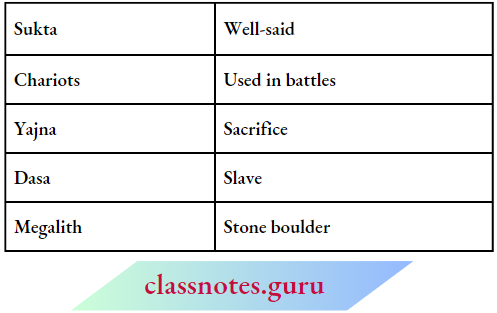
Read and Learn More NCERT Solutions For Class 6 Social Science
Question 2. Complete the sentences:
1. Slaves were used for ________________
Answer: doing different works as per the desire of his or her owner (or master).
2. Megaliths are found in ________________
Answer: The Deccan, south India, in the northeast and Kashmir.
3. Stone circles or boulders on the surface were used to ________________
Answer: Mark burial sites.
NCERT Solutions Class 6 History Chapter 4 What Books and Burials Tell Us
4. Port-holes were used for ________________
Answer: burying other members of the same family.
5. People at Inamgaon ate ________________
Answer: wheat, barley, rice, pulses, millets, peas, the meat of different animals, fish, the meat of birds and fruits such as ber, amla, jamun, dates, etc.
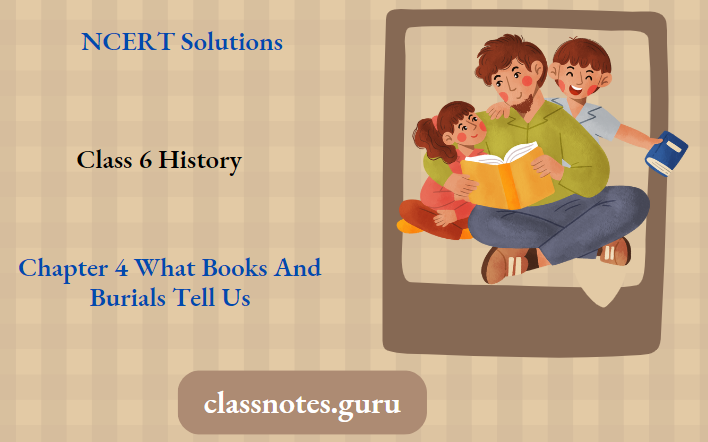
Question 3. In what ways are the books we read today different from the Rigveda?
Answer:
- The books we use today are written and printed. The Rigveda was recited and heard rather than read.
- For many years from generation to generation the process continued. It was written down several centuries after it was first composed, and printed less than 200 years ago.
Question 4. What kind of evidence from burials do archaeologists use to find out whether there were social differences amongst those who were buried?
Answer:
- Sometimes, archaeologists find a circle of stone boulders or a single large stone standing on the ground. These are the only indications that there are burials beneath.
- All these burials have some common features. Generally, the dead were buried with distinctive pots, which are called Black and Red Ware.
- Also found are tools and weapons of iron and sometimes, skeletons of horses, horse equipment, and ornaments of stone and gold.
- Several kinds of evidence from burial archaeologists find that there were social differences among those who were buried underneath megaliths.
- Perhaps there were differences in status amongst the people who were buried. Perhaps some were rich, others poor, some chiefs, others followers.
Question 5. In what ways do you think that the life of a was different from that of a dasa or dasi?
Answer:
Life of a raja was quite different from a dasa/dasi:
- Raja participated in religious rites. Took part in wars, dasas were not allowed to do so.
- Rajas were free and leaders of the area, whereas dasas were treated as property of the owners.
Question 6. Find out whether your school library has a collection of books on religion, and list the names of five books from this collection.
Answer:
Yes, our school library has a collection of books on religion.
List Of Books From School Library Collection:

Question 7. Write down a short poem or song that you have memorized. Did you hear or read the poem or song? How did you learn it by heart?
Answer:
Suggestion: Students may write National Anthem—Jana-gana-mana- adhinayaka.
जन-गण-मन अधिनायक जय हे
भारत-भाग्य-विधाता ।
पंजाब सिंध गुजरात मराठा
द्राविड़ उत्कल बंग।
विंध्य हिमाचल यमुना गंगा,
उच्छल जलधि तरंग | तव शुभ नामे जागे, तव शुभ आशिष माँगे; गाहे तव जय गाथा । जन-गण-मंगलदायक जय हे,
भारत-भाग्य-विधाता ।
जय हे, जय हे, जय हे, जय जय जय, जय हे ।।
Or
National Song—Vande Mataram MicHH).
We have heard as well as read the song. We have repeated it again and again. We have learnt it singing usually daily in our school Morning Assembly.
Question 8. In the Rigveda, people were described in terms of the work they did and the languages they spoke. In the table below, fill in the names of six people you know, choosing three men and three women. For each of them, mention the work they do and the language they speak. Would you like to add anything else to the description?
Answer:
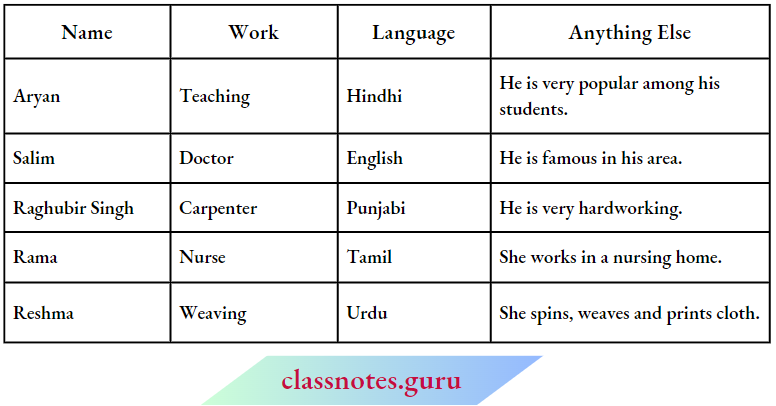
Question 9. There were several things that people did to make megaliths. Write them.
Answer:
People Did The Following Things:
- Digging pits in the earth
- Burying the dead
- Breaking boulders
- Finding suitable stones
- Shaping stones
- Transporting stones
- Placing the stones in position
What Books and Burials Tell Us Class 6 History Chapter 4 Solutions
Question 10. Was iron used in the Harappan cities?
Answer:
Yes, iron was used in the Harappan cities.
Question 11. Do you think this was the body of achievement? Give reasons for your answer.
Answer:
This was the body of a chief, because:
- The body of a chief is found with jewelry.
- The body of a chief is surrounded by well-decorated stones.
Question 12. How do you think he found out about the human body in such great detail?
Answer:
- Charka studied the human body very carefully. According to him, there are 360 bones in a human body.
- He arrived at this figure by counting teeth, joints, and cartilage along with the bones. However, according to modern anatomy, there are 200 bones in the human body.
Question 5. List the possible occupations of the people at Inamgaon.
Answer:
The Possible Occupations:
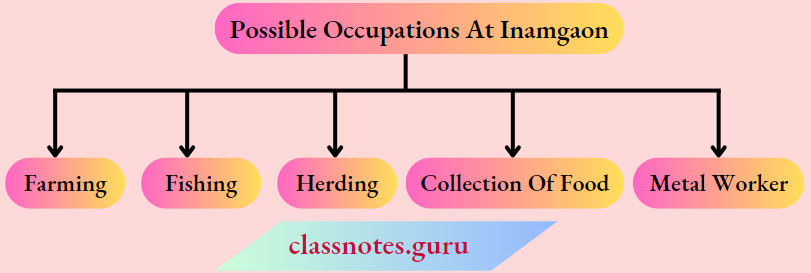
NCERT Solutions For Class 6 History Chapter 4 What Books And Burials Tell Us Very Short Answer Type Questions
Question 1. For which three things in Rigveda were the prayers performed especially?
Answer:
There are many prayers in the Rigveda for
- Cattle,
- Children (especially for sons), and
- Horses.
Question 2. Write the names of three vish or jana, as mentioned in the Rigveda.
Answer:
Several Vish or Jana are mentioned by name in the Rigveda. The three names given in it are:
- The Puru jana or vish,
- The Bharata jana or vish, and
- The Yadu jana or vish.
Question 3. List the names of rivers mentioned in the Vedas.
Answer:
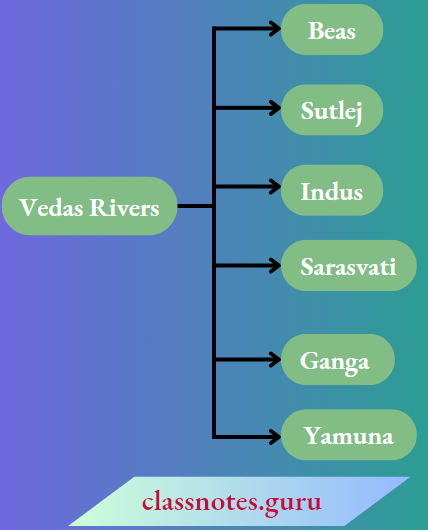
Question 4. Discuss in brief three Vedic gods, considered especially important.
Answer:
Three gods which are considered especially important:
- Agni,
- Indra, and
- Soma.
- Agni, the god of fire.
- Indra, a warrior god.
- Soma, a plant from which a special drink was prepared.
Question 5. Name the Vedas.
Answer:
There Are Four Vedas Namely
- Rigveda
- Yajurveda
- Samaveda
- Atharvaveda
NCERT Solutions For Class 6 History Chapter 4 What Books And Burials Tell Us Short Answer Type Questions
Question 1. For which three things were battles fought by the Rigvedic people?
Answer:
- Battles were fought to capture cattle.
- Battles were also fought for land, which was important for pasture, and for growing crops.
- Some battles were fought for water, and to capture people.
Question 2. What was the fate of booty or looted wealth during the battle or war days?
Answer:
- Some of the looted wealth (or booty) obtained was kept by the leaders.
- Some portion of looted wealth was given to priests (brahmins).
- The rest of the looted wealth was distributed amongst the people.
- Some wealth (looted in the war or battles) was used for performing yajnas or sacrifices in which offerings were made into the fire. These were meant for gods and goddesses. Offerings could include ghee butter, grain, and in some cases animals.
Question 3. Write any three main common features of war of the Rigvedic age.
Answer:
- Most men took part in wars during the Rigvedic age.
- There was no regular army, but there were assemblies where people met and discussed matters of war and peace.
- The assemblies also choose leaders, brave and skillful warriors.
Question 4. Were some burial spots meant for certain families? If yes, give some facts to prove your answer.
Answer:
Yes, some burial spots were definitely meant for certain families. We can give the following facts to prove our answer:
- Sometimes, megaliths, contain more than one skeleton. These indicate that people, perhaps belonging to the same family, were buried in the same place though not at the same time. The
- Stone circles or boulders on the surface probably served as signposts to, find the burial site so that people could return to the same place whenever they wanted to.
Chapter 4 What Books and Burials Tell Us NCERT Class 6
Question 5. Who was Charaka? What is the name of his work? Describe one of his contributions with regard to the human body.
Answer:
- Charaka was a famous ancient Indian Physician about 2000 years ago.
- Charaka wrote a book on medical science known as the ‘Charaka Samhita’.
- Charaka has stated in his book that the human body has 360 bones. This is a much larger number than the 200 bones that are recognized in modern anatomy.
- Charaka arrived at this figure by counting the teeth, joints, and cartilage.
Question 6. Discuss “Food at Inamgaon” as archaeologists have found different proofs from different sites.
Answer:
Food at Inamgaon
- Archaeologists have found seeds of wheat, barley, rice, pulses, millets, peas, and sesame at Inamgaon.
- Bones of a number of animals, bearing cut marks that show they may have been used as food, have also been found. These include buffalo, goat, sheep, dog, horse, ass, pig, sambhar, spotted deer, blackbuck, antelope, hare, mongoose, birds, crocodile, turtle, crab and fish.
- There is evidence that fruits such as her, amla, jamun, dates, and a variety of berries were collected.
Question 7. Describe the words Aryas and Dasas (Dasyus) used for the people.
Answer:
- Aryas. Sometimes, the people who composed the hymns described themselves as Aryas.
- Dasas or Dasyus. Aryas called their opponents, Dasas or Dasyus. These were people who did not perform yajana and probably spoke different languages (other than Sanskrit).
Question 8. Who were slaves in Vedic society? Write a very short note about them.
Answer:
During the later Vedic Age, the term dasa (and the feminine dasi) meant slave.
Slaves were men and women who were generally captured in war. They were treated as the property of their owners (or masters) who could make them do whatever work they desired.
NCERT Solutions For Class 6 History Chapter 4 What Books And Burials Tell Us Long Answer Type Questions
Question 1. Describe different classes or categories of people as referred to or described in Rigveda.
Answer:
Words Of The Rigveda To Describe Different Classes Or Categories Of The People:
- There are several ways of describing people—in terms of the work they do, the language they speak, the place they belong to, their families, their communities, and cultural practices.
- Broadly speaking, there were two groups (of people) who were described in terms of their work—the priests sometimes called brahmins, who performed various rituals for the rajas. These rajas were not like the ones you will be learning about later (in the coming chapters).
- Two words were used (in the Rigveda) to describe people or the community as a whole. One was the word Jana, which we still use in Hindi and other languages. The other was Vish. The word Vaishya comes from Vish.
Question 2. How do we know who was buried in the graves?
Answer:
We know who was buried in the graves with the help of the following clues:
- It is easy to check out the skeleton of a child from its small size. However, there are no major skeletal differences between a girl and a boy.
- We can check out whether a skeleton was that of a man or a woman. We can decide this thing on the basis of what is found in the skeleton. For example, if a skeleton is found with jewelry, it is sometimes thought to be that of a woman.
- However, there are problems with this. Generally, men also wore ornaments.
- A better (or more reliable) way of finding the sex of a skeleton is from the bone structure. The hip area of a woman is generally larger to enable childbearing.
What Books and Burials Tell Us NCERT Solutions Chapter 4
Question 3. Give a brief account of the major features of a Special Burial found at Inamgaon.
Answer:
A Special Burial Found at Inamgaon and its Major Features
- At Inamgaon, the scholars have found a special burial. It is a site on the river Ghod, a tributary of the Bhima. It was occupied between 3600 and 2700 years ago.
- Here, adults were often buried under the ground, laid out straight, with the head towards the north.
- Sometimes, burials were within houses. Vessels, that probably contained food and water, were placed with the dead.
- One man was found buried in a large four-legged clay jar in the courtyard of a five-roomed house (one of the largest houses at the site) in the center of the settlement. This house also had a granary. The body was placed in a cross-legged position.
Question 4. Write a short note on one of the oldest books in the world.
Answer:
- Vedas are known as the oldest books in the world.
- There are four of them—the Rigveda, Samaveda, Yajurveda, and Atharvaveda.
- The oldest Veda is the Rigveda, composed about 3500 years ago.
- The Rigveda includes more than a thousand hymns, called sukta or “wellsaid”. These hymns are in praise of different gods and goddesses.
- These hymns were composed by sages (rishis).
- These Vedas are written in Vedic Sanskrit. The Vedic or old Sanskrit is different from the Sanskrit that we learn in school these days.
- These hymns are in praise of various gods and goddesses.
- The Rigveda was recited and heard rather than written or read.
- The Rigveda was written down several centuries before. It was first printed less than 200 years ago.
Question 5. Write a short note on the megaliths.
Answer:
- Silent sentinels or stone boulders are known as megaliths (big stones).
- Megaliths were carefully arranged by people and were used to mark burial sites.
- The practice of erecting megaliths began about 3000 years ago, and was prevalent throughout the Deccan, south India, in the north-east and Kashmir.
- While some megaliths can be seen on the surface, other megalithic burials are underground.
NCERT Solutions For Class 6 History Chapter 4 What Books And Burials Tell Us Map Skills
On the outline map of India locate the following:
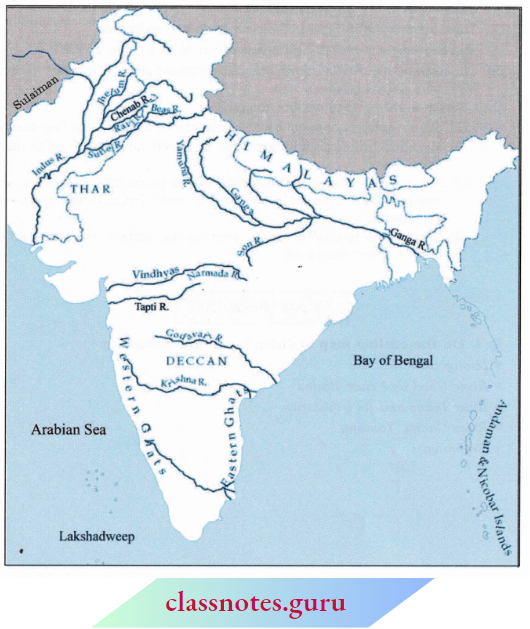
Answer:
- Inamgaon
- River Ghod and River Bhima
- River Indus and its tributaries
- River Ganga, Yamuna
- Brahmagiri
NCERT Class 6 History Chapter 4 Study Material
NCERT Solutions For Class 6 History Chapter 4 What Books And Burials Tell Us Multiple-Choice Questions
Choose The Correct Answer
Question 1. Which of the following is the oldest Veda?
- Samaveda
- Yajurveda
- Rigveda
- Ayurveda
Answer: 3. Rigveda
Question 2. Who is the ‘god of fire’ according to Rigveda?
- Agni
- Indra
- Soma
- None of these
Answer: 1. Agni
Question 3. In which language is The Rigveda’ written?
- Vedic Sanskrit
- Vedic Hindi
- Vedic Tamil
- None of these
Answer: 1. Vedic Sanskrit
Question 4. Which of the two rivers are mentioned in the Rigveda?
- Ganga and Yamuna
- Beas and Sultej
- Saraswati and Brahamputra
- All of these
Answer: 2. Beas and Sultej
Question 5. When was the Rigveda written?
- About 3500 years ago
- About 1000 years ago
- About 500 years ago
- About 1500 years ago
Answer: 1. About 3500 years ago
Question 6. On which bark was the Rigveda written?
- Neem Bark
- Cinchona Bark
- Tulsi Bark
- Birch Bark
Answer: 4. Birch Bark
Question 7. Which were the two words used to describe the people or the community as a whole?
- Jana and Vish
- Aiyas and Dasas
- Both (1) and (2)
- None of these
Answer: 1. Jana and Vish
Question 8. In which region was the Rigveda composed?
- North-east
- North-west
- North-south
- Western-east
Answer: 2. North-west
Question 9. When the dead body was buried with gold beads it means that the dead man was a
- Rich man
- Poor man
- Chief
- Follower
Answer: 1. Rich man
Question 10. The evidence of which fruits were found?
- Ber, Amla, Jamun
- Mango
- Apple
- All of these
Answer: 1. Ber, Amla, Jamun
What Books and Burials Tell Us Chapter 4 Class 6 History Notes
NCERT Solutions For Class 6 History Chapter 4 What Books And Burials Tell Us Objective Type Questions
Question 1. Fill in the blanks with appropriate words
1. _______ was a warrior god.
Answer: Indra
2. Inamgaon is on the banks of river ______ a tributary of river ______
Answer: Ghod, Bhima
3. Brahmagiri a site of megaliths is situated in modem day state of _______
Answer: Andhra Pradesh
4. Adults were buried with their heads towards _______ direction.
Answer: North
5. The hymns in Vedas were composed by _______
Answer: Sages
Question 2. Write whether the given statement is true or false.
1. Some of the hymns in Rigveda are in dialogue form.
Answer: True
2. There are many prayers in Rigveda for daughters.
Answer: False
NCERT Class 6 History Chapter 4 Study Material
3. The kings collected taxes and there were regular armies.
Answer: False
4. Boulders used for burial sites were called megaliths.
Answer: True
5. According to Charaka there are 200 bones in our body.
Answer: False
Question 3. Match the contents of Column A with that of Column B.
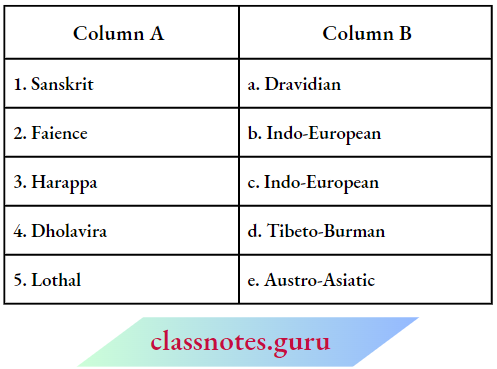
Answer: 1-(b), 2-(d), 3-(a), 4-(e), 5-(c)
